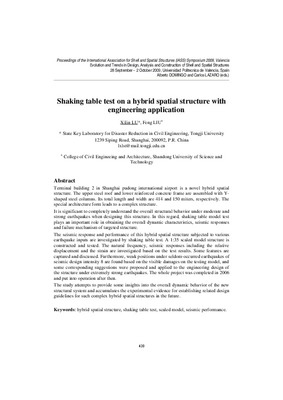JavaScript is disabled for your browser. Some features of this site may not work without it.
Buscar en RiuNet
Listar
Mi cuenta
Estadísticas
Ayuda RiuNet
Admin. UPV
Shaking table test a hybrid spatial structure with engineering application
Mostrar el registro sencillo del ítem
Ficheros en el ítem
| dc.contributor.author | LU, Xilin
|
|
| dc.contributor.author | LIU, Feng
|
|
| dc.contributor.editor | Domingo Cabo, Alberto
|
es_ES |
| dc.contributor.editor | Lázaro Fernández, Carlos Manuel
|
es_ES |
| dc.date.accessioned | 2009-12-01T08:22:38Z | |
| dc.date.available | 2009-12-01T08:22:38Z | |
| dc.date.issued | 2009-12-01T08:22:38Z | |
| dc.identifier.isbn | 978-84-8363-461-5 | |
| dc.identifier.uri | http://hdl.handle.net/10251/6534 | |
| dc.description | p. 420-431 | en_EN |
| dc.description.abstract | Terminal building 2 in Shanghai pudong international airport is a novel hybrid spatial structure. The upper steel roof and lower reinforced concrete frame are assembled with Yshaped steel columns. Its total length and width are 414 and 150 miters, respectively. The special architecture form leads to a complex structure. It is significant to completely understand the overall structural behavior under moderate and strong earthquakes when designing this structure. In this regard, shaking table model test plays an important role in obtaining the overall dynamic characteristics, seismic responses and failure mechanism of targeted structure. The seismic response and performance of this hybrid spatial structure subjected to various earthquake inputs are investigated by shaking table test. A 1:35 scaled model structure is constructed and tested. The natural frequency, seismic responses including the relative displacement and the strain are investigated based on the test results. Some features are captured and discussed. Furthermore, weak positions under seldom-occurred earthquakes of seismic design intensity 8 are found based on the visible damages on the testing model, and some corresponding suggestions were proposed and applied to the engineering design of the structure under extremely strong earthquakes. The whole project was completed in 2006 and put into operation after then. The study attempts to provide some insights into the overall dynamic behavior of the new structural system and accumulates the experimental evidence for establishing related design guidelines for such complex hybrid spatial structures in the future. | en_EN |
| dc.language | Inglés | en_EN |
| dc.publisher | Editorial Universitat Politècnica de València | es_ES |
| dc.relation.ispartof | Symposium of the International Association for Shell and Spatial Structures (50th. 2009. Valencia). Evolution and Trends in Design, Analysis and Construction of Shell and Spatial Structures : Proceedings | en_EN |
| dc.rights | Reserva de todos los derechos | en_EN |
| dc.subject | Hybrid spatial structure | en_EN |
| dc.subject | Shaking table test | en_EN |
| dc.subject | Scaled model | en_EN |
| dc.subject | Seismic performance | en_EN |
| dc.title | Shaking table test a hybrid spatial structure with engineering application | en_EN |
| dc.type | Comunicación en congreso | en_EN |
| dc.rights.accessRights | Abierto | es_ES |
| dc.description.bibliographicCitation | Lu, X.; Liu, F. (2009). Shaking table test a hybrid spatial structure with engineering application. Editorial Universitat Politècnica de València. http://hdl.handle.net/10251/6534 | es_ES |
| dc.relation.conferencename | Symposium of the International Association for Shell and Spatial Structures | es_ES |
| dc.relation.conferencedate | 2009 | es_ES |
| dc.relation.conferenceplace | Valencia | es_ES |






